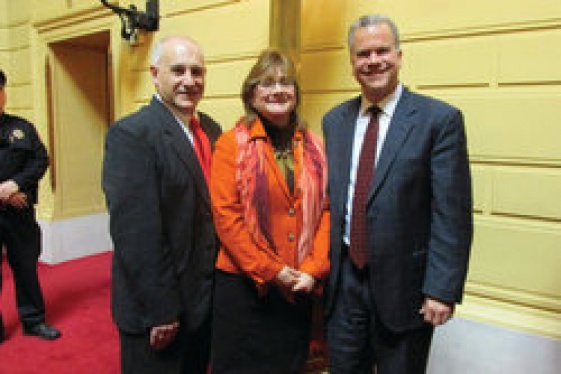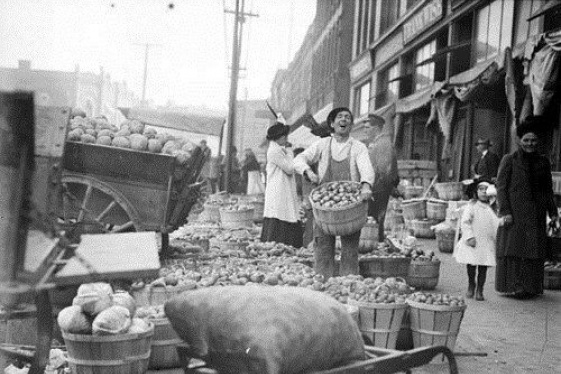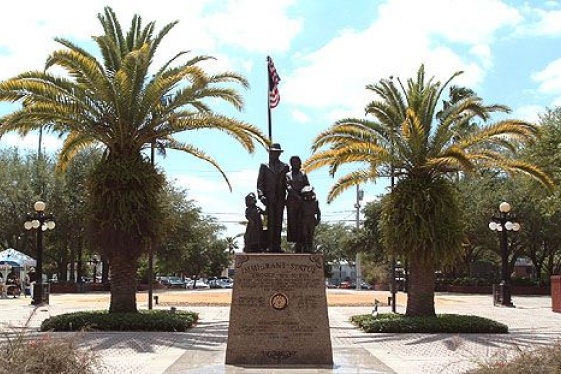
Sandra Gengler (President of the Italian Cultural Center of Minneapolis/St. Paul)
Incontriamo Sandra Gengler, che ci dà il benvenuto nell'Italia in Minnesota

You know that sometimes in these interviews I have the pleasure of knowing leaders of Italian and Italian American communities throughout the United States. Today my personal tour of America takes me to the North Star State, Minnesota, where I meet Sandra Gengler. Born and raised in Ancona, in the Marche region, she moved to the US to attend college where she earned an MBA from the Kelley School of Business at Indiana University. In college she met her husband.
After a fulfilling marketing career, Sandra now offers her time and expertise to the Italian Cultural Center of Minneapolis/St. Paul where she was elected President of the Board of Directors in 2018. Also, this year, she earned the title of Cavaliere dell’Ordine della Stella d’Italia for her work and dedication to the promotion of Italian culture in the Twin Cities.
President Gengler, please tell us about the history and activities of the Italian Cultural Center of Minneapolis/St. Paul.
Founded in 2006, the Italian Cultural Center represents a focal point of all things Italian in the Twin Cities. True to its mission – promoting Italian language and culture - we strive to create a broad and inclusive cultural community by serving as a beacon for classic and contemporary Italian culture through its language, arts, food, science, and technology.
We are an independent, self-sustaining, non-political, non-profit organization, duly incorporated in the State of Minnesota.
Today, the Italian Cultural Center includes over 400+ active members and 2,000+ followers and participants across all demographics. The development of our programs and initiatives are inspired by the audiences we serve: Italian nationals who moved to the Twin Cities in pursuit of educational and professional opportunities; Italian Americans whose ancestors immigrated to the US and wish to (re)gain a better understanding of the language and current Italian culture; as well as Italophiles who want to deepen their appreciation of Italy’s artistic and cultural heritage.
We offer many different activities.
From the very beginning we have established a comprehensive language program. Our curriculum, based on the Common European Framework of Reference (CEFR), includes a wide range of classes from Beginning to Advanced level and provides a full program of study, all year around. Our university-educated native instructors bring first-hand experience and a cultural background of Italian life and current traditions to the classroom.
Then there’s cinema. Launched in 2009, the Italian Film Festival of Minneapolis/St. Paul is our marquis annual event. Over the course of four days, the festival features prominent current first run Italian films and documentaries. Over the years, several Italian directors have participated to provide commentary and insights into their films to our Minnesota audience. The festival opens with a big “Opening Night” party. This year, we hosted Director Phaim Bhuiyan, winner of the prestigious David di Donatello for Best New Director, who presented his film “Bangla”.
We also offer other kinds of cultural events. From lectures and literary discussions to performances, art tours, cooking classes, wine-tastings and concerts, we offer many opportunities to understand Italy’s rich heritage and to celebrate Italian culture. Over the years we have hosted hundreds of events, large and small with successful collaborations with major cultural and educational institutions from and outside Minnesota. More recent examples include the exclusive concert by Giacomo Benedetti, Florentine organist in March 2020, the LEONARDO500 series of events celebrating Da Vinci’s genius on the occasion of the 500th anniversary of his death in the Fall of 2019 and the unique theatrical performance by Sicilian master-puppeteer Mimmo Cuticchio (a rare opportunity outside of Italy), in October 2018.
Last but not least, our educational trips. We partner with schools across Italy who specialize in teaching Italian to foreigners. Together, we prepare a custom 2-week itinerary which includes immersive language classes, as well as tours and unique cultural experiences in the surrounding territory. One board member from the Italian Cultural Center travels with the small group to offer a fuller experience. We typically offer one trip each year. Our goal is to offer a deep dive into less visited regions, not usually promoted by large tour operators. Our most recent trips, before Covid, have been to Marche and Friuli.
For additional information or to become a member, I encourage We the Italians’ reader to visit our website www.theitalianculturalcenter.org
We ask you to tell us something about Italian emigration to Minnesota. Who were the Italian emigrants, what did they come to Minnesota to do when they arrived, and from which parts of our country?
Minnesota became the 32nd state of the union in 1858. Of the millions of Italians who over the decades immigrated to the United States, very few chose Minnesota as their new home. In 1910 the Italian-born population of Minnesota peaked at 9,688 and then began to fall as Italian immigrants continued to pour into other Midwestern states. As of 2017, more 125,000 people of Italian ancestry live in Minnesota and represent the 10th largest group in the state.
Originally, Italians gathered in four main areas of the state: St. Paul, Minneapolis, Duluth, and towns across an area called the Iron Range. In this rural area, early arrivals tended to be from northern Italy and worked the mines extracting iron ore. Italians, like other southern and eastern Europeans, faced social prejudices. Over time, the Americanization process overcame ethnic distinctions. The construction of recreational facilities led to the fielding of excellent athletic teams. In ice hockey, Italians are represented by John Mariucci, Doug Palazzari, Andrew Peter (“Andy”) Gambucci and countless more athletes – the sons of immigrant Italians who took on this unlikely Italian sport and became legends.
The immigrants from southern Italy, instead, settled in St. Paul, in an area of town called the Upper Levee, along the Mississippi river. Employment opportunities attracted them to the growing city of St. Paul. Many of the men were employed by the railroad immediately bordering their community. The life of a railroad laborer was difficult and working conditions were harsh. By mid-century, after decades of flooding, the families had largely abandoned their neighborhoods, moving out of the river’s reach. Italians also created a tight knit community in the Northeast area of Minneapolis called Beltrami, named after Italian explorer, Giacomo Beltrami.
Both areas of Minneapolis and St. Paul, were home to famous Italian eateries and shops such as Delmonico’s and Café di Napoli; others like Mancini’s and Cossetta’s are still going strong today.
Are there places, or people, that more than others represent the history of the Italian community in Minnesota?
It’s worth mentioning a few names and how their diverse contributions influenced and enriched our lives in Minnesota.
Giacomo Beltrami was born in Bergamo. Beltrami traveled to the US in 1823. Setting off with Ojibwe Indian guides, he began a personal quest to find the source of the Mississippi river in central Minnesota. Upon the discovery, he named the place Giulia (Lake Julia) after his beloved friend Giulia Spada dei Medici and eight nearby lakes after her children. His discovery proved to be incorrect, as the Mississippi’s true source at nearby Lake Itasca remained unknown to European-Americans until 1832.
Several Minnesota landmarks reflect Beltrami’s renown as an explorer of the Upper Mississippi. Beltrami County, Beltrami Island State Forest, and the Beltrami neighborhood in Northeast Minneapolis are named in his honor.
Anthony Adducci was a pioneer of the medical device industry and co-founder of Cardiac Pacemakers Inc. (later Guidant) which now operates as a subsidiary of Boston Scientific. His company manufactured the world's first lithium battery powered artificial pacemaker.
Rose Totino invented the first pizza dough suitable for freezing and subsequent baking. With her husband, she started Totino’s Finer Foods in Minneapolis which became the foundation for the Totino's brand. After selling the company to Pillsbury, Rose became their first female corporate vice president.
Robert Mondavi was a leading California vineyard operator. Robert was born in Virginia, a small town in the Iron Range. His technical and marketing strategies brought worldwide recognition for the wines of the Napa Valley in California.
John Mariucci, athlete and coach, was known as the Godfather of Hockey. John was born in Eveleth, in the Minnesota Iron Range. He played both ice hockey and football for the University of Minnesota and went on to play professional hockey. He became the head coach of the Minnesota Golden Gophers hockey team and led them to multiple victories. In 1993, the University honored him by naming the new hockey venue Mariucci Arena.
How is the distribution of Made in Italy in Minnesota? Are there Italian companies selling Italian products? Are there opportunities for companies in our country?
Valued at approx. 500 million US$ in 2018, Italy ranked as Minnesota’s 7th largest source of imports. Machinery, beverages, electrical equipment, pharmaceuticals, optic/medical and vehicles are the primary imported products. Several Italian companies have offices and/or production facilities in Minnesota. Similarly, many Fortune 500 companies with headquarters in Minnesota have offices and production facilities across Italy.
Minnesota offers many notable economic opportunities to companies who decide to establish themselves within its territory. Some of these opportunities include being ranked at the top of “quality of life” indicators, such as health care, education, infrastructures, natural environment, to name a few. Our cold winter climate is often cited as the only detractor. Like most Italians who have made Minnesota their new home, I know how brutal the winters here can be. Nonetheless, we often encourage new transplants to embrace our winters by dressing appropriately and enjoying winter sports and activities.
As far as you can foresee it, how do you see the future of your institution in this new world marked by the presence of covid-19?
Since its inception, the Italian Cultural Center has continued to grow and evolve into the vibrant and healthy organization that we enjoy today. Over the years, we have increased our offering of language classes and events which found an ever-expanding and appreciative audience. Covid-19 has presented unprecedented challenges to the very survival of many non-profit organizations operating in the cultural space, such as ours. With great determination, we responded by changing our services delivery model while following all health safeguards: in March, we closed our location and moved our language classes online. To our great delight, our members responded enthusiastically and registration numbers did not suffer. This Fall, we continue to offer online classes. We look forward to reopening our classrooms in the coming months, as health conditions allow.
Cultural events and presentations have naturally been most impacted by Covid-19, as we halted all in-person events. In their place, we curated a series of Zoom meetings, live from Italy, called “Storie di famiglia: Made in Italy - Meet the people behind the label” aimed at connecting food and wine lovers to storied producers of iconic wine and food products. Similarly, we organized online art meetings called “Il Salotto degli Artisti”, connecting with contemporary artists in Italy. To keep our community engaged, we publish a weekly digital column “Il caffè di oggi” covering topics ranging from art, history, literature, music, food and much more that offer “virtual” jolts of caffeine to brighten our readers’ day.
If the health restrictions won’t ease in 2021, our greatest challenge will be rethinking how to deliver our Italian Film Festival next February. While we understand that gathering in a packed movie theater and mingling at the opening party won’t be likely this year, cancelling is not in our plans. Instead, we are evaluating hosting an all online festival. The format poses a lot of challenges, but we owe it to our community that made the IFF a beloved tradition in the Twin Cities.
Minneapolis is where George Floyd was killed last May 25th. What impact has this tragedy had on you?
The brutal killing of Mr. Floyd represented a moment of reckoning and of great sadness for the U.S., the city of Minneapolis and all of us at the Italian Cultural Center.
In the days following the events, the Italian Cultural Center stood in solidarity with the community. We are committed to continue promoting a culture of inclusiveness and understanding which offers a path to constructive and lasting change. In such occasion, we expressed our position through a quote from the late Italian President, Sandro Pertini, who decades ago so eloquently stated: “Non vi può essere vera libertà senza giustizia sociale, come non vi può essere giustizia sociale senza libertà” (There can be no true freedom without social justice, as there can be no true social justice without freedom). These words spoken decades ago are still relevant today, in the U.S. and across the world.
You may be interested
-
“The Hill” St. Louis’ Little Italy
When the fire hydrants begin to look like Italian flags with green, red and white stripes,...
-
An Unlikely Union: The love-hate story of Ne...
Award-winning author and Brooklynite Paul Moses is back with a historic yet dazzling sto...
-
Italian world language teacher 2015-2016
FRAMINGHAM PUBLIC SCHOOLS - JOB DESCRIPTION TITLE: World Language Teacher - Italian...
-
New York Italians Movie Night: "C'eravamo ta...
Dear Friends, New York Italians in collaboration with Fordham University, Department...
-
Polisena delivers address as state lawmakers...
"Italian-Americans came to our country, and state, poor and proud," Johnston Mayor Joseph...
-
The “Little Italies” of Michigan
In doing reseach for this post, I was sure that Italian immigrants found their way to Detr...
-
Ybor City – Florida’s Little Italy
"The people who had lived for centuries in Sicilian villages perched on hilltops for prote...
-
''La Gente di Mulberry Street'' presentato a...
Valsinni- Italia, terra di emigranti. Presentato a Valsinni il nuovo saggio storico di Raf...






























